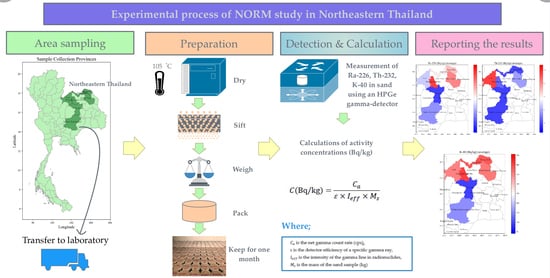Measurement of NORM in Building Materials to Assess Radiological Hazards to Human Health and Develop the Standard Guidelines for Residents in Thailand: Case Study in Sand Samples Collected from Seven Northeastern Thailand Provinces
Abstract
:1. Introduction
2. Materials and Methods
2.1. Study Area
2.2. Sample Collection and Preparation
2.3. Gamma-Ray Detector and Calibration
2.4. Radioactivity Measurement, Dose and Hazard Index Calculation
3. Results and Discussion
4. Conclusions
Author Contributions
Funding
Data Availability Statement
Acknowledgments
Conflicts of Interest
Appendix A
| Province | ||||
|---|---|---|---|---|
| (1 × 10−3) | ||||
| Loei | 37 ± 5 | 0.05 ± 0.01 | 0.16 ± 0.03 | 0.16 ± 0.02 |
| Nong Bua Lum Phu | 43 ± 5 | 0.05 ± 0.01 | 0.25 ± 0.04 | 0.18 ± 0.02 |
| Khon Kaen | 12 ± 7 | 0.01 ± 0.01 | 0.11 ± 0.05 | 0.05 ± 0.03 |
| Nakhon Ratchasima | 18 ± 0 | 0.02 ± 0.02 | 0.14 ± 0.06 | 0.08 ± 0.06 |
| Nong Khai | 35 ± 6 | 0.04 ± 0.01 | 0.18 ± 0.06 | 0.15 ± 0.02 |
| Bueng Kan | 37 ± 8 | 0.05 ± 0.01 | 0.20 ± 0.08 | 0.16 ± 0.03 |
| Sakon Nakhon | 39 ± 5 | 0.05 ± 0.01 | 0.22 ± 0.06 | 0.17 ± 0.02 |
| Average | 32 ± 12 | 0.04 ± 0.02 | 0.18 ± 0.05 | 0.14 ± 0.05 |
References
- Raghu, Y.; Ravisankar, R.; Chandrasekarn, A.; Vijayagopal, P.; Venkatraman, B. Assessment of natural radioactivity and radiological hazards in building materials used in the Tiruvannamalai District, Tamilnadu, India, using a statistical approach. J. Taibah Univ. Sci. 2017, 11, 523–533. [Google Scholar] [CrossRef] [Green Version]
- Klepeis, N.E.; Nelson, W.C.; Ott, W.R.; Robinson, J.P.; Tsang, A.M.; Switzer, P. The National Human Activity Pattern Survey (NHAPS) A Resource for Assessing Exposure to Environmental Pollutants. J. Expo. Sci. Environ. Epidemiol. 2001, 11, 231–252. [Google Scholar] [CrossRef] [PubMed] [Green Version]
- United Nations Scientific Committee on the Effects of Atomic Radiation. Sources and Effects of Ionizing Radiation, United Nations Scientific Committee on the Effects of Atomic Radiation; UNSCEAR 2000 Report to the General Assembly with Scientific Annex B. Exposures from Natural Radiation Sources; United Nations: New York, NY, USA, 2000; Volume I. [Google Scholar]
- The International Commission on Radiological Protection. Annals of the ICRP.1990, Recommendations of the International Commission on Radiological Protection. ICRP Publication 60; Pergamon Press: Oxford, UK, 1991. [Google Scholar]
- International Commission on Radiological Protection. The 2007 Recommendations of the International Commission on Radiological Protection; ICRP Publication 103. Ann. ICRP 37; Elsevier: Amsterdam, The Netherlands, 2007. [Google Scholar]
- Smetsers, R.C.G.M.; Tomas, J.M. A practical approach to limit the radiation dose from building materials applied in dwelling, in compliance with the Euratom Basic Safety Standards. J. Environ. Radioact 2018, 196, 40–49. [Google Scholar] [CrossRef] [PubMed]
- CE 2014. Council Directive 2013/59/Euratom of 5 Dec. 2013 Laying Down Basic Safety Standards for Protection against the Dangers Arising from Exposure to Ionising Radiation; Office for Official Publications of the European Communities: Luxembourg, 2014; Volume 57. [Google Scholar]
- European Commission (EC). Radiation Protection 112, Radiological Protection Principles Concerning the Natural Radioactivity of Building Materials; Office for Official Publications of the European Communities: Luxembourg, 1999. [Google Scholar]
- Xinwei, L.; Xiaolan, Z. Measurement of natural radioactivity in sand samples collected from the Baoji Weihe Sands Park, China. Environ. Geol. 2006, 50, 977–982. [Google Scholar] [CrossRef]
- Vasconcelos, D.C.; Pereira, C.; Oliveira, A.H.; Santos, T.O.; Rocha, Z.; Menezes, D.B.C.M.A. Determination of natural radioactivity in beach sand in the extreme south of Bahia, Brazil, using gamma spectrometry. Radiat Prot. Environ. 2011, 34, 178–184. [Google Scholar]
- Malain, D.; Regan, P.H.; Bradley, D.A.; Matthews, M.; Santawamaitre, T.; Al-Sulaiti, H.A. Measurements of NORM in beach sand samples along the Andaman coast of Thailand after the 2004 tsunami. Nucl. Instrum. Methods. Sect. A Accel. Spectrometers Detect. Assoc. Equip. 2010, 619, 441–445. [Google Scholar] [CrossRef]
- Dabayneh, K.; Mashal, L.; Hasan, F. Radioactivity concentration in soil samples in the southern part of the West Bank, Palestine. Radiat. Prot. Dosim. 2008, 131, 265–271. [Google Scholar] [CrossRef] [PubMed]
- European Commission (EC). Radiation Protection, 112 Radioactivity of Building Materials, Directorate-General Environment. Nuclear Safety and Civil Protection; Office for Official Publications of the European Communities: Luxembourg, 1999. [Google Scholar]
- Bereka, J.; Mathew, P.J. Natural radioactivity of Australian building material, industrial wastes and by products. Health Phys. 1985, 48, 87–95. [Google Scholar] [CrossRef] [PubMed]
- El-Taher, A.; Makhut, S.; Nossair, A.; Halim, A.S.A. Assessment of natural radioactivity levels and radiation hazards due to cement industry. Appl. Radiat. Isot. 2012, 68, 169–174. [Google Scholar] [CrossRef] [PubMed]
- Vaeth, M.; Pierce, D.A. Calculating excess lifetime risk in relative risk models. Environ. Health Perspect. 1990, 87, 83–94. [Google Scholar] [CrossRef] [PubMed]
- Loan, T.T.H.; Ba, V.N.; Bang, N.V.T.; Thy, T.H.N.; Hong, H.T.Y.; Huy, N.Q. Natural radioactivity and radiological health hazard assessment of chemical fertilizers in Viet Nam. J. Radioanal. Nucl. Chem. 2018, 316, 111–117. [Google Scholar] [CrossRef]
- Radenkovic, M.B.; Alshikh, S.M.; Andric, V.D.; Miljanic, S.S. Radioactivity of sand from several renowned public beaches and assessment of the corresponding en-vironmental risks. J. Serb. Chem. Soc. 2009, 74, 461–470. [Google Scholar] [CrossRef]
- Alaamer, A.S. Measurement of natural radioactivity in sand samples collected from Ad-Dahna desert in Saudi Arabia. World J. Nuclear Sci. Technol. 2012, 2, 187–191. [Google Scholar] [CrossRef]
- Ahmed, M.M.; Das, S.K.; Sariful; Yeasmin, S. Natural radioactivity and dose assessment in sand and sediment samples from Kuakata beach, Bangladesh. J. Bangladesh Acad. Sci. 2016, 40, 45–55. [Google Scholar] [CrossRef] [Green Version]
- Kessaratikoon, P.; Benjakul, S.; Udomsomporn, S. Distribution of Natural radionuclides in Songkla beach sand. Kasatsart J. (Nat. Sci.) 2007, 41, 157–164. [Google Scholar]
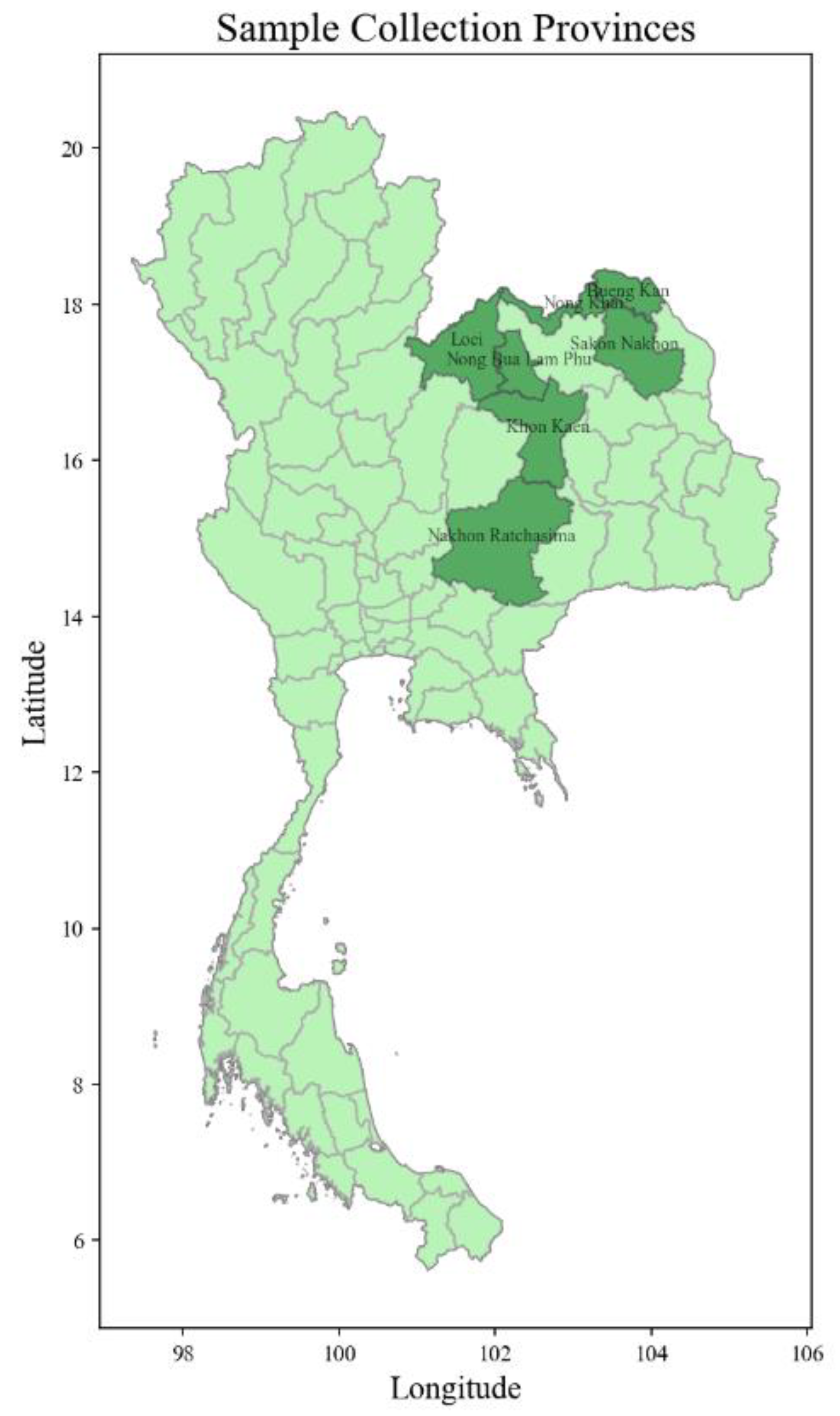
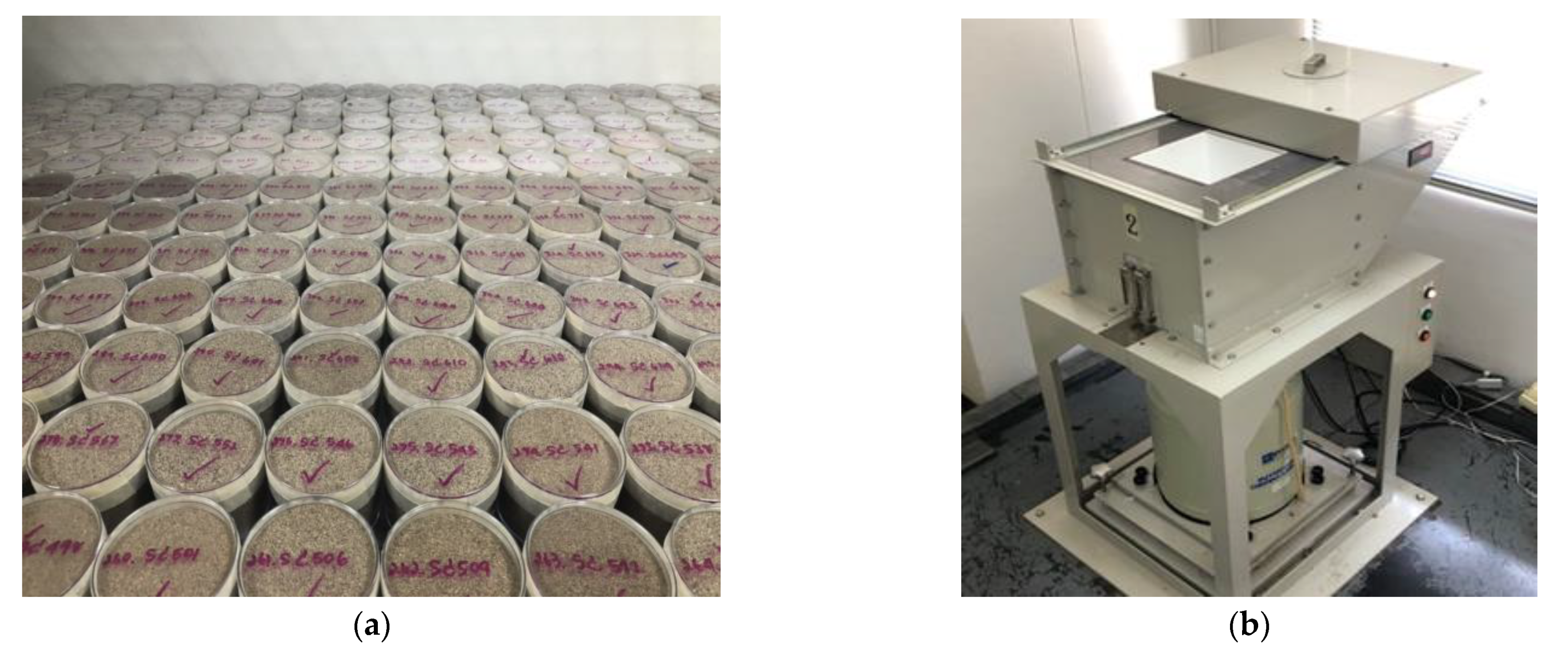
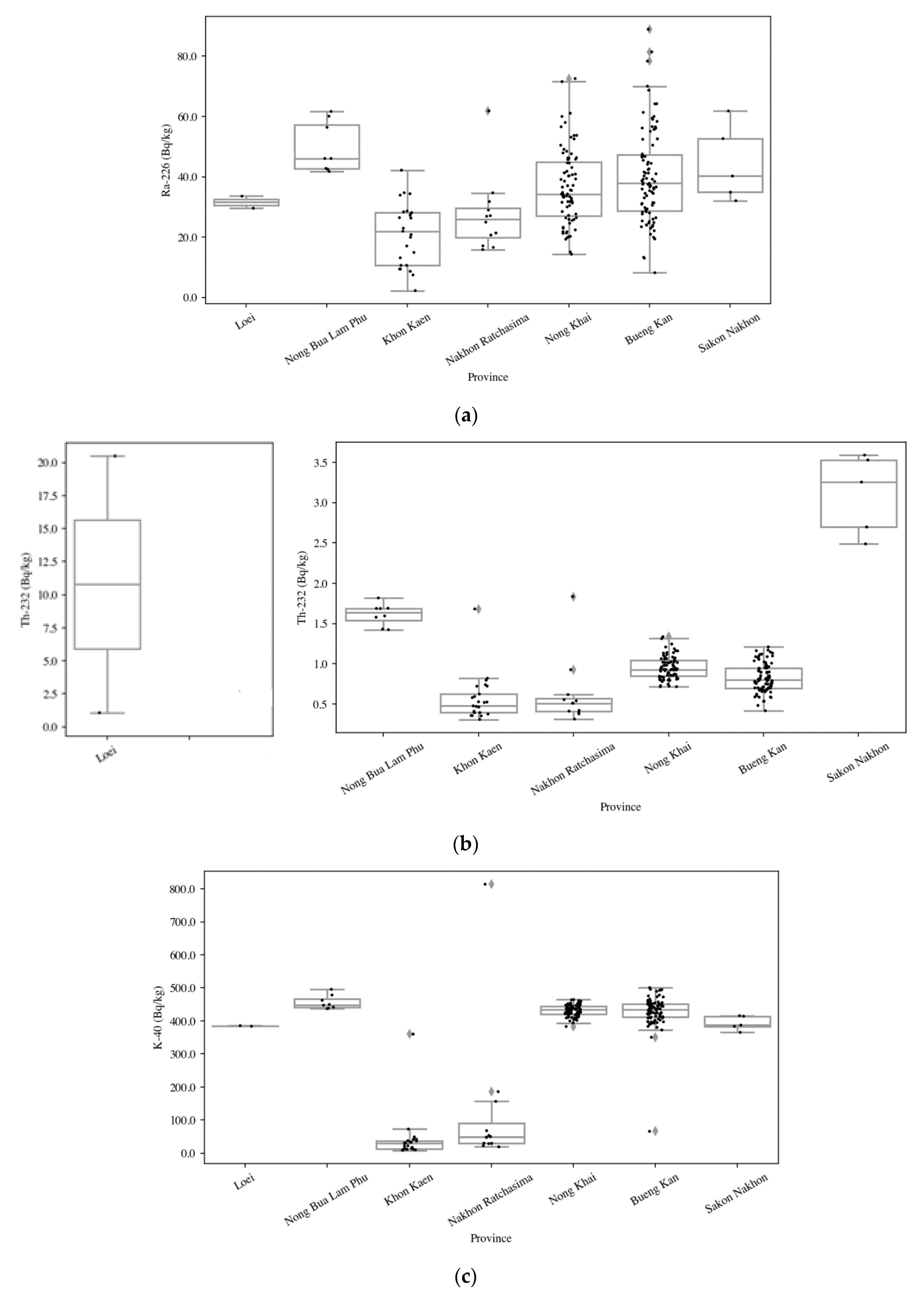
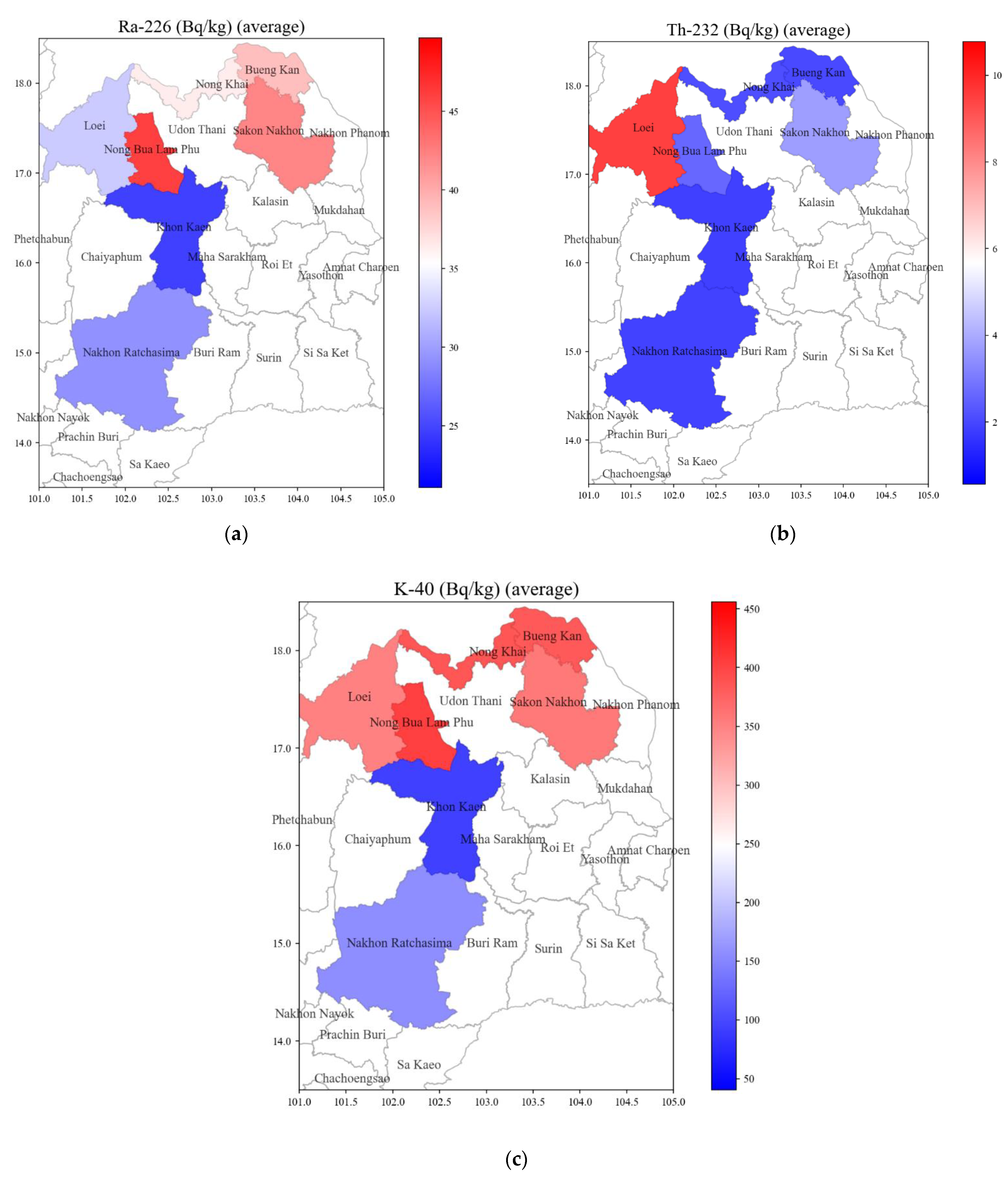
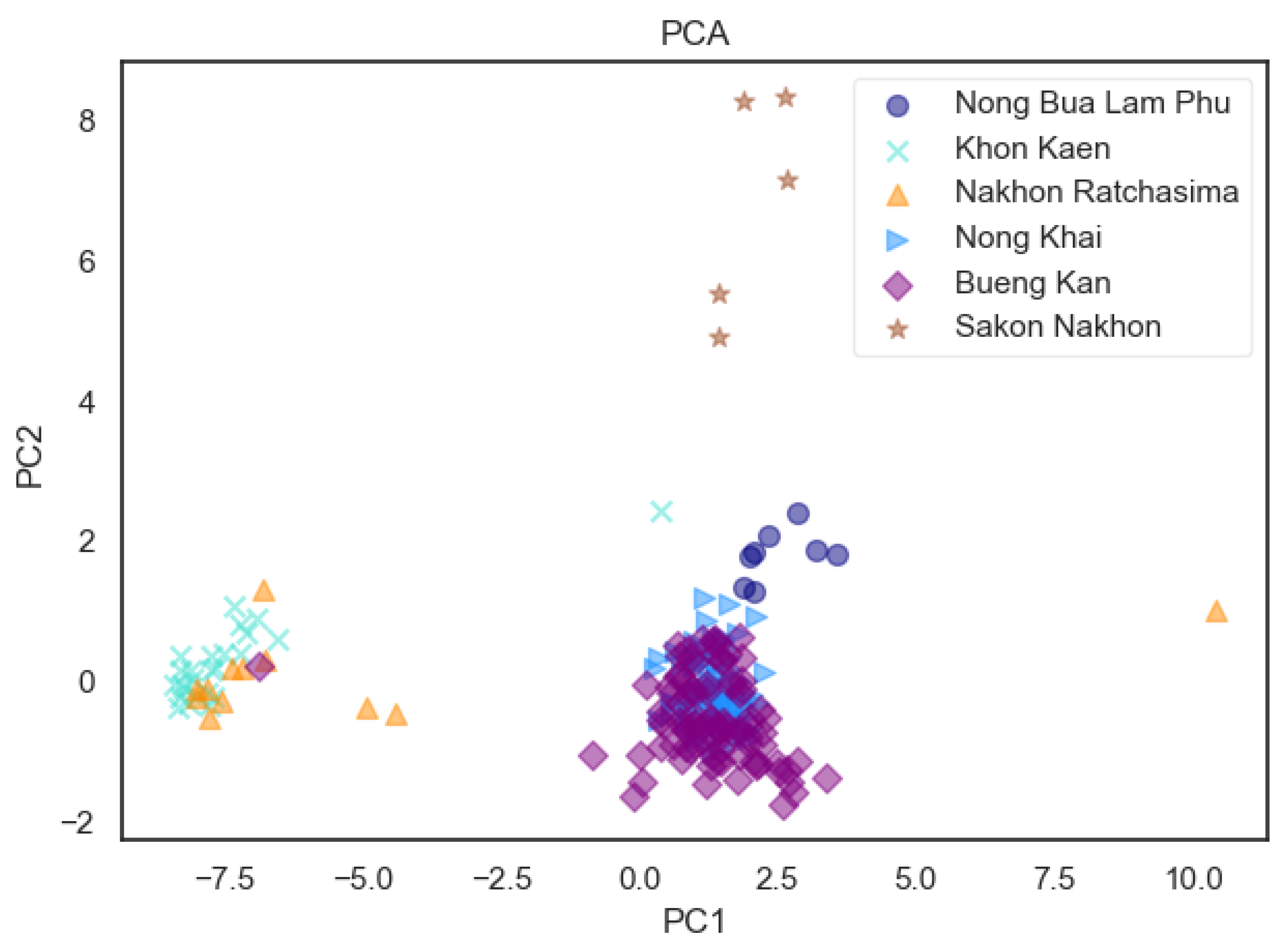
| Does Criterion | ||
|---|---|---|
| Materials used in bulk amounts, e.g., concrete | ≤ 0.5 | ≤ 1 |
| Superficial and other materials with restricted use: tiles, boards, etc. | ≤ 2 | ≤ 6 |
| Provinces | No. of Sample | ||||||
|---|---|---|---|---|---|---|---|
| Ra-226 | Th-232 | K-40 | |||||
| Avg ± SD | Min–Max | Avg ± SD | Min–Max | Avg ± SD | Min–Max | ||
| Loei | 2 | 32 ± 7 | 30–34 | 10.78 ± 1.86 | 1.07–20.49 | 385 ± 11 | 384–386 |
| Nong Bua Lum Phu | 8 | 50 ± 8 | 42–62 | 1.61 ± 0.14 | 1.42–1.82 | 456 ± 21 | 437–496 |
| Khon Kaen | 25 | 21 ± 10 | 2–42 | 0.56 ± 0.28 | 0.31–1.68 | 40 ± 68 | 9–360 |
| Nakhon Ratchasima | 12 | 27 ± 12 | 16–62 | 0.62 ± 0.42 | 0.31–1.84 | 125 ± 283 | 19–814 |
| Nong Khai | 80 | 37 ± 12 | 14–73 | 0.96 ± 0.14 | 0.71–1.34 | 432 ± 18 | 383–465 |
| Bueng Kan | 91 | 40 ± 15 | 8–89 | 0.83 ± 0.18 | 0.42–1.21 | 429 ± 48 | 65–500 |
| Sakon Nakhon | 5 | 44 ± 13 | 21–62 | 3.11 ± 0.50 | 2.49–3.59 | 393 ± 22 | 365–393 |
| Total/Average/Range | 223 | 36 ± 10 | 2–89 | 2.64 ± 0.58 | 0.31–20.49 | 323 ± 168 | 9–814 |
| Provinces | |||||||
|---|---|---|---|---|---|---|---|
| (1 × 10−3) | |||||||
| Loei | 72 ± 9 | 0.35 ± 0.03 | 0.29 ± 0.03 | 77 ± 10 | 0.21 ± 0.03 | 0.29 ± 0.03 | 1.23 ± 0.15 |
| Nong Bua Lum Phu | 84 ± 9 | 0.41 ± 0.05 | 0.33 ± 0.03 | 87 ± 10 | 0.24 ± 0.03 | 0.32 ± 0.05 | 1.44 ± 0.16 |
| Khon Kaen | 23 ± 13 | 0.11 ± 0.07 | 0.09 ± 0.05 | 25 ± 14 | 0.07 ± 0.04 | 0.12 ± 0.07 | 0.40 ± 0.23 |
| Nakhon Ratchasima | 36 ± 29 | 0.18 ± 0.14 | 0.14 ± 0.11 | 38 ± 29 | 0.10 ± 0.08 | 0.18 ± 0.11 | 0.62 ± 0.49 |
| Nong Khai | 69 ± 112 | 0.34 ± 0.06 | 0.27 ± 0.04 | 71 ± 12 | 0.19 ± 0.03 | 0.29 ± 0.07 | 1.19 ± 0.20 |
| Bueng Kan | 72 ± 16 | 0.35 ± 0.08 | 0.28 ± 0.06 | 74 ± 17 | 0.20 ± 0.05 | 0.31 ± 0.09 | 1.24 ± 0.27 |
| Sakon Nakhon | 76 ± 11 | 0.37 ± 0.05 | 0.29 ± 0.04 | 79 ± 12 | 0.21 ± 0.03 | 0.33 ± 0.07 | 1.30 ± 0.19 |
| Average | 62 ± 23 | 0.30 ± 0.11 | 0.24 ± 0.09 | 64 ± 23 | 0.17 ± 0.06 | 0.26 ± 0.08 | 1.06 ± 0.39 |
| Country | Ra-226 | Th-232 | K-40 | Ref. | ||||||
|---|---|---|---|---|---|---|---|---|---|---|
| USA | 5 ± 1 | 17 ± 2 | 457 ± 44 | 33 | 0.03 | 0.51 | 65 | 0.18 | Radenkovic et al. 2009 [18] | |
| Brazil | 2 ± 0.36 | 6 ± 0.75 | 19 ± 2 | 6 | 0.01 | 0.09 | 13 | 0.03 | Radenkovic et al. 2009 [18] | |
| Saudi Arabia | 23 ± 4 | 30 ± 6 | 380 ± 65 | 46 ± 6 | 0.28 ± 0.04 | 95 ± 13 | 0.26 ± 0.03 | 0.32 ± 0.04 | Alaamer, 2012 [19] | |
| Bangladesh | 49 ± 5 | 126 ± 3 | 292 ± 18 | 131 | 0.64 | 238 | 0.64 | 0.77 | Ahmed et al. 2016 [20] | |
| Thailand | 41 ± 5 | 64 ± 7 | 248 ± 44 | 69 | 152 ± 18 | Kessaratikoon et al. 2007 [21] | ||||
| Thailand | 36 ± 10 | 2.64 ± 0.58 | 323 ± 168 | 62 ± 23 | 0.30 ± 0.11 | 0.24 ± 0.09 | 64 ± 23 | 0.17 ± 0.06 | 0.26 ± 0.08 | This study |
| World averages | 35 | 30 | 400 | 51 | 0.50 | UNSCEAR, 2000 [3] | ||||
| Guideline levels | 1 | <1 | 370 | <1 | <1 | UNSCEAR, 2000 [3] |
Publisher’s Note: MDPI stays neutral with regard to jurisdictional claims in published maps and institutional affiliations. |
© 2021 by the authors. Licensee MDPI, Basel, Switzerland. This article is an open access article distributed under the terms and conditions of the Creative Commons Attribution (CC BY) license (https://creativecommons.org/licenses/by/4.0/).
Share and Cite
Sola, P.; Injarean, U.; Picha, R.; Kranrod, C.; Kukusamude, C.; Tokonami, S. Measurement of NORM in Building Materials to Assess Radiological Hazards to Human Health and Develop the Standard Guidelines for Residents in Thailand: Case Study in Sand Samples Collected from Seven Northeastern Thailand Provinces. Atmosphere 2021, 12, 1024. https://doi.org/10.3390/atmos12081024
Sola P, Injarean U, Picha R, Kranrod C, Kukusamude C, Tokonami S. Measurement of NORM in Building Materials to Assess Radiological Hazards to Human Health and Develop the Standard Guidelines for Residents in Thailand: Case Study in Sand Samples Collected from Seven Northeastern Thailand Provinces. Atmosphere. 2021; 12(8):1024. https://doi.org/10.3390/atmos12081024
Chicago/Turabian StyleSola, Phachirarat, Uthaiwan Injarean, Roppon Picha, Chutima Kranrod, Chunyapuk Kukusamude, and Shinji Tokonami. 2021. "Measurement of NORM in Building Materials to Assess Radiological Hazards to Human Health and Develop the Standard Guidelines for Residents in Thailand: Case Study in Sand Samples Collected from Seven Northeastern Thailand Provinces" Atmosphere 12, no. 8: 1024. https://doi.org/10.3390/atmos12081024






